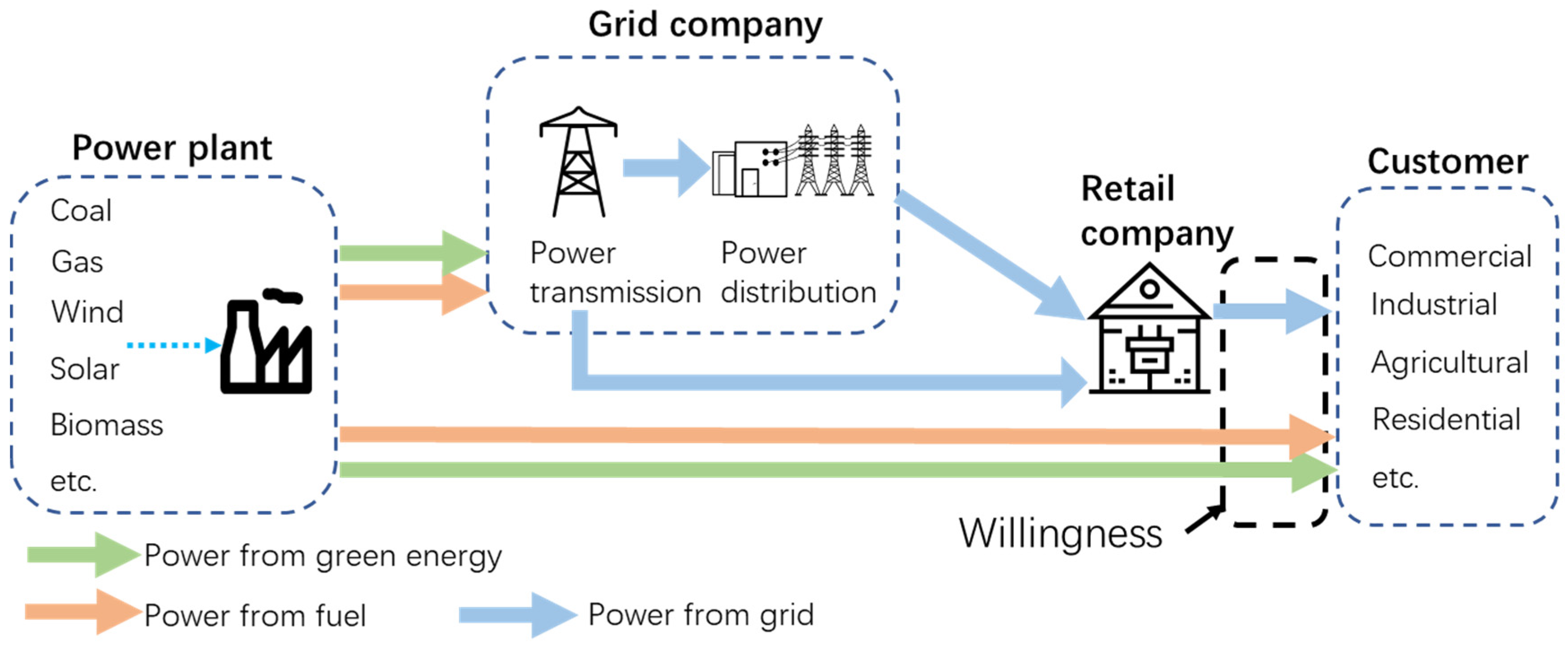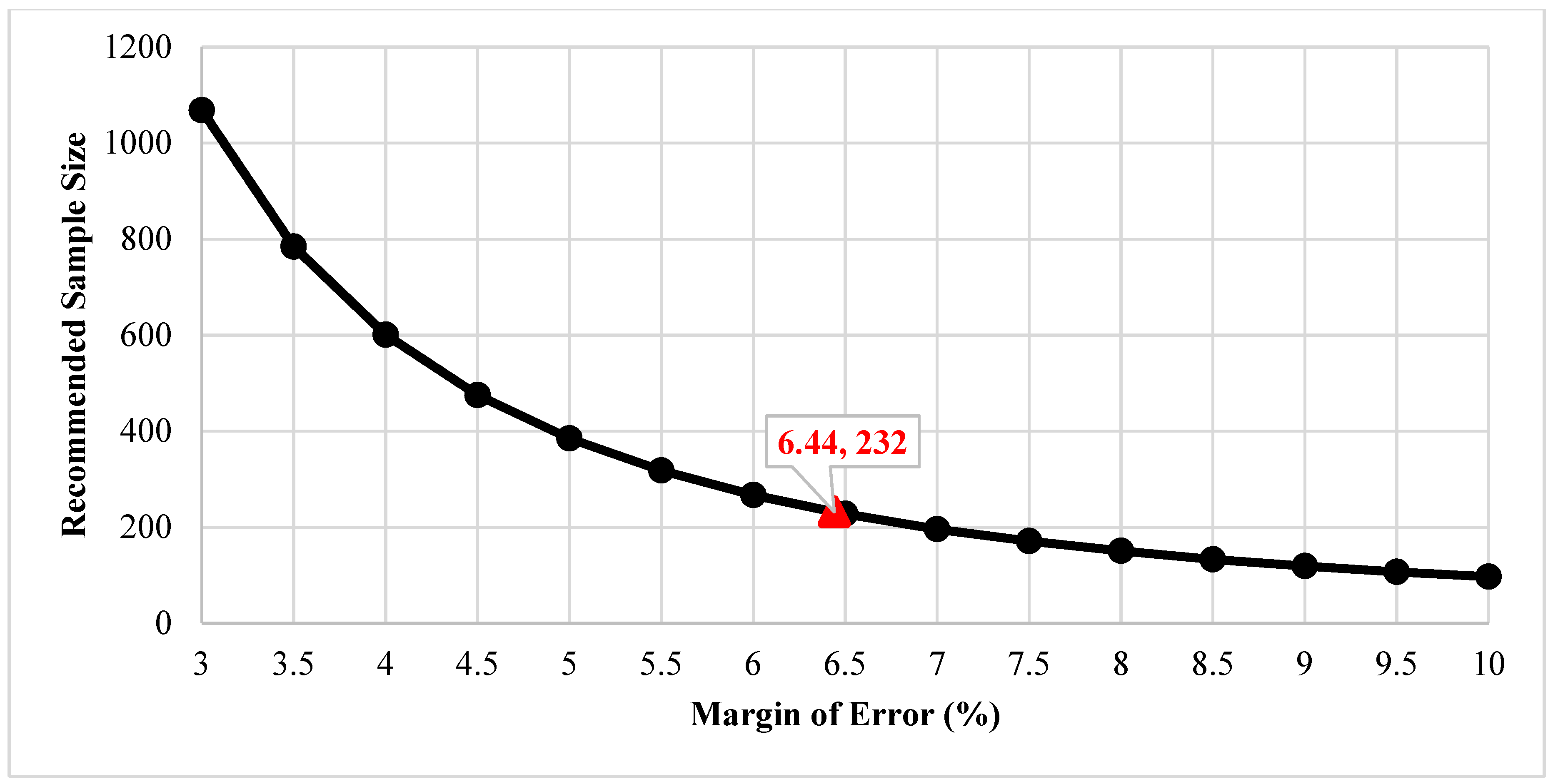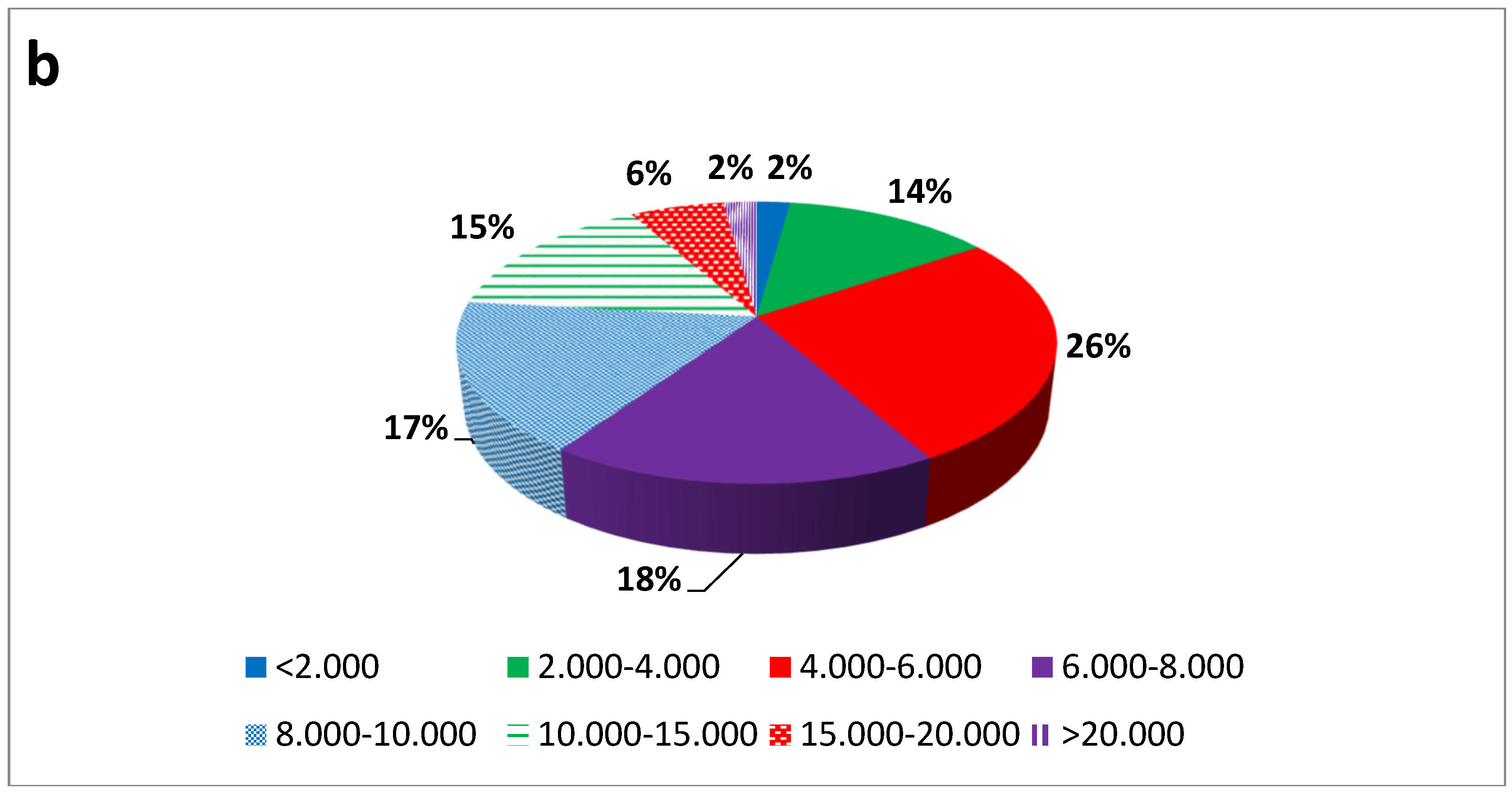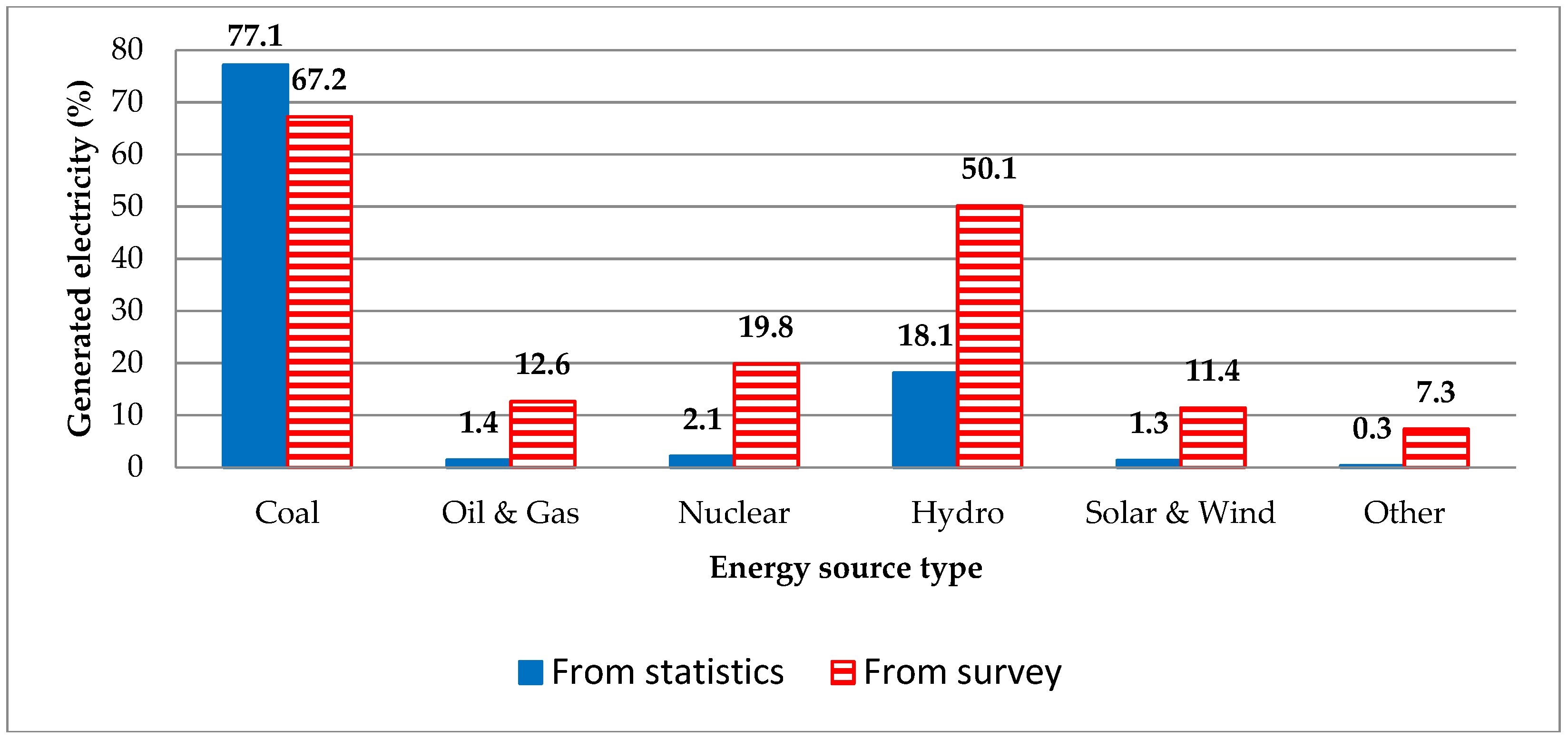Consumers’ Attitudes to Support Green Energy: A Case Study in Shanghai
Abstract
:1. Introduction
1.1. Literature Review
1.2. China’s Electricity Market Strategies
2. Materials and Methods
2.1. Background
2.2. Awareness
2.3. Attitudes
2.4. Technology
2.4.1. Solar Energy
2.4.2. Wind Power
2.4.3. Hydropower
2.4.4. Tidal Power
2.5. Barriers and Behaviours
2.6. Open Question
3. Results and Discussion
3.1. Qualitative Survey Analysis
3.1.1. Background
3.1.2. Awareness
3.1.3. Attitudes
3.1.4. Technology and Resources
3.1.5. Barriers
- Willing to be pro-environmental in diverse ways.
- Flexible FITs for the GEPs based on consumers’ information.
- Share energy (electricity, heating and etc.) with other householders.
- Mobile the GEPs, for example, a small scale of mobile PV modules.
3.2. Statistical Analysis
4. Conclusions
Author Contributions
Funding
Acknowledgments
Conflicts of Interest
Appendix A
References
- Chen, H.; Huang, Y.; Shen, H.; Chen, Y.; Ru, M.; Chen, Y.; Lin, N.; Su, S.; Zhuo, S.; Zhong, Q.; et al. Modeling temporal variations in global residential energy consumption and pollutant emissions. Appl. Energy 2015, 184, 820–829. [Google Scholar] [CrossRef]
- REN21: Global Renewable Energy Policy Multi-Stakeholder Network. Available online: http://www.ren21.net/ (accessed on 4 June 2019).
- Mitigating Climate Change—Greenhouse Gas Emissions. Available online: https://www.eea.europa.eu/soer-2015/countries-comparison/climate-change-mitigation (accessed on 4 June 2019).
- Hast, A.; Alimohammadisagvand, B.; Syri, S. Consumer attitudes towards renewable energy in China—The case of Shanghai. Sustain. Cities Soc. 2015, 17, 69–79. [Google Scholar] [CrossRef]
- Xingang, Z.; Jieyu, W.; Xiaomeng, L.; Pingkuo, L. China’s wind, biomass and solar power generation: What the situation tells us? Renew. Sustain. Energy Rev. 2012, 16, 6173–6182. [Google Scholar] [CrossRef]
- Hao, Y.; Liao, H.; Wei, Y.-M. Is China’s carbon reduction target allocation reasonable? An analysis based on carbon intensity convergence. Appl. Energy 2015, 142, 229–239. [Google Scholar] [CrossRef]
- Liu, W.; Wang, C.; Mol, A.P.J. Rural public acceptance of renewable energy deployment: The case of Shandong in China. Appl. Energy 2013, 102, 1187–1196. [Google Scholar] [CrossRef]
- Shanghai, China. Available online: http://www.shanghai.gov.cn/shanghai/node27118/ (accessed on 28 August 2015).
- Dhakal, S. Urban energy use and carbon emissions from cities in China and policy implications. Energy Policy 2009, 37, 4208–4219. [Google Scholar] [CrossRef]
- China Statistical Yearbook Compiled by National Bureau of Statistics of China. Available online: http://www.stats.gov.cn/tjsj/ndsj/2014/indexeh.htm (accessed on 28 August 2015).
- Zhao, Y.; Tang, K.K.; Wang, L. Do renewable electricity policies promote renewable electricity generation? Evidence from panel data. Energy Policy 2013, 62, 887–897. [Google Scholar] [CrossRef]
- Zsiborács, H.; Hegedűsné Baranyai, N.; Csányi, S.; Vincze, A.; Pintér, G. Economic Analysis of Grid-Connected PV System Regulations: A Hungarian Case Study. Electronics 2019, 8, 149. [Google Scholar] [CrossRef]
- Wang, F.; Wang, L. Research on Renewable Energy Policies and Pricing Mechanisms. IOP Conf. Ser. Earth Environ. Sci. 2018, 186, 012068. [Google Scholar] [CrossRef]
- Salmela, S.; Varho, V. Consumers in the green electricity market in Finland. Energy Policy 2006, 34, 3669–3683. [Google Scholar] [CrossRef]
- Hast, A.; Syri, S.; Jokiniemi, J.; Huuskonen, M.; Cross, S. Review of green electricity products in the United Kingdom, Germany and Finland. Renew. Sustain. Energy Rev. 2015, 42, 1370–1384. [Google Scholar] [CrossRef]
- Baležentis, T.; Štreimikienė, D. Sustainability in the Electricity Sector through Advanced Technologies: Energy Mix Transition and Smart Grid Technology in China. Energies 2019, 12, 1142. [Google Scholar] [CrossRef]
- Sun, X.; Feng, Y. Analysis of Barriers and Strategies for China’s Green Power Market. Energy Procedia 2012, 17, 1401–1407. [Google Scholar] [CrossRef]
- Gliedt, T.; Hoicka, C.E. Energy upgrades as financial or strategic investment? Energy Star property owners and managers improving building energy performance. Appl. Energy 2015, 147, 430–443. [Google Scholar]
- Bird, L.; Wüstenhagen, R.; Aabakken, J. A review of international green power markets: Recent experience, trends, and market drivers. Renew. Sustain. Energy Rev. 2002, 6, 513–536. [Google Scholar] [CrossRef]
- Chan, K.-Y.; Oerlemans, L.A.G.; Volschenk, J. On the construct validity of measures of willingness to pay for green electricity: Evidence from a South African case. Appl. Energy 2015, 160, 321–328. [Google Scholar] [CrossRef]
- Nomura, N.; Akai, M. Willingness to pay for green electricity in Japan as estimated through contingent valuation method. Appl. Energy 2004, 78, 453–463. [Google Scholar] [CrossRef]
- Hast, A.; McDermott, L.; Syri, S.; Järvel;, M.; Huuskonen, M.; Alimohammadisagvand, B.; Cross, S.; Syrjämäki, E. Consumer Demand of Renewable Energy Services—Case Studies on Finland, Germany, Great Britain, USA and China; Aalto University Publication; Aalto University: Espoo, Finland, 2014; ISBN 978-952-60-5743-9. [Google Scholar]
- Kim, J.; Kim, J. Korean public’s perceptions on supply security of fossil fuels: A contingent valuation analysis. Appl. Energy 2015, 137, 301–309. [Google Scholar] [CrossRef]
- Kraeusel, J.; Möst, D. Carbon Capture and Storage on its way to large-scale deployment: Social acceptance and willingness to pay in Germany. Energy Policy 2012, 49, 642–651. [Google Scholar] [CrossRef]
- Alimohammadisagvand, B.; Hast, A.; Syri, S.; Cao, G. Chinese consumer attitudes and barriers towards green energy. In Proceedings of the International Sustainable Built Environment Conference, Doha, Qatar, 28–29 January 2014. [Google Scholar]
- Zorić, J.; Hrovatin, N. Household willingness to pay for green electricity in Slovenia. Energy Policy 2012, 47, 180–187. [Google Scholar] [CrossRef]
- Ozbafli, A.; Jenkins, G.P. The willingness to pay by households for improved reliability of electricity service in North Cyprus. Energy Policy 2015, 87, 359–369. [Google Scholar] [CrossRef]
- Simões, F. Consumer Behavior and Sustainable Development in China: The Role of Behavioral Sciences in Environmental Policymaking. Sustainability 2016, 8, 897. [Google Scholar] [CrossRef]
- Guanghua, S.; Wanda, G.; Ruoqi, L. Identification and analysis on influential factors of payment for green product environment premium. J. Arid Land Resour. Environ. 2018, 6. Available online: http://en.cnki.com.cn/Article_en/CJFDTotal-GHZH201806002.htm (accessed on 4 June 2019).
- Liu, Y.; Hong, Z.; Zhu, J.; Yan, J.; Qi, J.; Liu, P. Promoting green residential buildings: Residents’ environmental attitude, subjective knowledge, and social trust matter. Energy Policy 2018, 112, 152–161. [Google Scholar] [CrossRef]
- Zhang, L.; Fukuda, H.; Liu, Z. Households’ willingness to pay for green roof for mitigating heat island effects in Beijing (China). Build. Environ. 2019, 150, 13–20. [Google Scholar] [CrossRef]
- Zhang, L.; Chen, L.; Wu, Z.; Zhang, S.; Song, H. Investigating Young Consumers’ Purchasing Intention of Green Housing in China. Sustainability 2018, 10, 1044. [Google Scholar] [CrossRef]
- Liu, W. Design of Competition Power Market Based on the Unbundling of Retail and Distribution; North China Electric Power University: Beijing, China, 2015. [Google Scholar]
- Energy Research Institute. China State Grid Economic and Technological Research Institute Co., Ltd. Annual Report. Available online: http://www.chinasperi.sgcc.com.cn/ (accessed on 26 December 2015).
- Bai, Y.; Zhong, H.; Xie, L.; Xia, Q.; Chen, Q. Institutional Design of Chinese Retail Electricity Market Reform and Related Suggestions. Autom. Electr. Power Syst. 2015, 39, 1–7. [Google Scholar]
- China State Council. An Announcement on Approval of “The Guideline of Major Tasks to Deepen Economic Structure Reform in 2013”; National Development and Reform Commission: Beijing, China, 2013.
- China State Council Central Committee of the Communist Party of China. Some Suggestions for Further Deepening Power System Reform; China State Council Central Committee of the Communist Party of China: Beijing, China, 2015. [Google Scholar]
- Li, K.; Lin, B. Impact of energy conservation policies on the green productivity in China’s manufacturing sector: Evidence from a three-stage DEA model. Appl. Energy 2016, 168, 351–363. [Google Scholar] [CrossRef]
- Zhou, Y.; Liu, Y. Does population have a larger impact on carbon dioxide emissions than income? Evidence from a cross-regional panel analysis in China. Appl. Energy 2016, 180, 800–809. [Google Scholar] [CrossRef]
- Cochran, W.G. Sampling Techniques, Wiley Series in Probability and Mathematical Statistics; 2nd ed.; Wiley: New York, NY, USA, 1963; ISBN 978-0-471-16238-4. [Google Scholar]
- Ryan, T.P. Sample Size Determination and Power; Wiley: Hoboken, NJ, USA, 2013; ISBN 978-1-118-43760-5. [Google Scholar]
- Shanghai Municipal People’s Government Shanghai Electric Power Development “Twelfth Five Year Plan”. Available online: http://www.shanghai.gov.cn/shanghai/node2314/node25307/node25455/node25459/u21ai569504.html (accessed on 1 June 2014).
- Raadal, H.L.; Gagnon, L.; Modahl, I.S.; Hanssen, O.J. Life cycle greenhouse gas (GHG) emissions from the generation of wind and hydro power. Renew. Sustain. Energy Rev. 2011, 15, 3417–3422. [Google Scholar] [CrossRef]
- Zhang, S.; Bauer, N.; Luderer, G.; Kriegler, E. Role of technologies in energy-related CO2 mitigation in China within a climate-protection world: A scenarios analysis using REMIND. Appl. Energy 2014, 115, 445–455. [Google Scholar] [CrossRef]
- Sun, X.; Zhang, B.; Tang, X.; McLellan, B.; Höök, M. Sustainable Energy Transitions in China: Renewable Options and Impacts on the Electricity System. Energies 2016, 9, 980. [Google Scholar] [CrossRef]
- He, M.; Liu, P.; Ma, L.; Chong, C.; Li, X.; Song, S.; Li, Z.; Ni, W. A Systems Analysis of the Development Status and Trends of Rural Household Energy in China. Energies 2018, 11, 1741. [Google Scholar] [CrossRef]
- Ming, Z.; Song, X.; Mingjuan, M.; Xiaoli, Z. New energy bases and sustainable development in China: A review. Renew. Sustain. Energy Rev. 2013, 20, 169–185. [Google Scholar] [CrossRef]
- Wang, B.; Kocaoglu, D.F.; Daim, T.U.; Yang, J. A decision model for energy resource selection in China. Energy Policy 2010, 38, 7130–7141. [Google Scholar] [CrossRef]
- Wang, B.; Ke, R.-Y.; Yuan, X.-C.; Wei, Y.-M. China’s regional assessment of renewable energy vulnerability to climate change. Renew. Sustain. Energy Rev. 2014, 40, 185–195. [Google Scholar] [CrossRef]
- Yang, M.; Patiño-Echeverri, D.; Yang, F. Wind power generation in China: Understanding the mismatch between capacity and generation. Renewable Energy 2012, 41, 145–151. [Google Scholar] [CrossRef]
- Science Press. Chinese Academy of Engineering Medium-and-Long-Term (2030, 2050) Energy Development Strategy Study of China’s Energy; Science Press: Beijing, China, 2011; ISBN 978-7-03-029944-4. [Google Scholar]
- Khatib, T.; Mohamed, A.; Sopian, K. A review of solar energy modeling techniques. Renew. Sustain. Energy Rev. 2012, 16, 2864–2869. [Google Scholar] [CrossRef]
- Sun, Y.; Wang, F.; Wang, B.; Chen, Q.; Engerer, N.A.; Mi, Z. Correlation Feature Selection and Mutual Information Theory Based Quantitative Research on Meteorological Impact Factors of Module Temperature for Solar Photovoltaic Systems. Energies 2016, 10, 7. [Google Scholar] [CrossRef]
- Mauthner, F.; Weiss, W.; Spörk-Dur, M. Solar Heat Worldwide, Markets and Contribution to the Energy Supply. Available online: http://www.iea-shc.org/data/sites/1/publications/Solar-Heat-Worldwide-2015.pdf (accessed on 26 December 2015).
- China State Council Several Options on Healthy Development Promotion of Solar Photovatic Industry. Available online: http://www.gov.cn/xxgk/pub/govpublic/mrlm/201307/t20130715_66188.html (accessed on 26 December 2015).
- Shanghai Finance Bureau Shanghai Municipal Development and Reform Commission. Notice on Issue of “Support Policy on Development Funding of Renewable Energy and New Energy in Shanghai”; Shanghai Finance Bureau Shanghai Municipal Development and Reform Commission: Shanghai, China, 2014.
- Tabassum-Abbasi;Premalatha, M.; Abbasi, T.; Abbasi, S.A. Wind energy: Increasing deployment, rising environmental concerns. Renew. Sustain. Energy Rev. 2014, 31, 270–288. [Google Scholar] [CrossRef]
- Li, J.; Gao, H.; Shi, J.; Ma, L.; Qing, L. China Wind Power. Available online: http://cwera.cma.gov.cn/cn/ (accessed on 27 May 2014).
- Global Wind Report GWEC’s Global Wind Report-Annual Market Update. Available online: http://www.gwec.net/publications/global-wind-report-2/global-wind-report-2013/ (accessed on 25 August 2014).
- Wang, Q. Effective policies for renewable energy—The example of China’s wind power—Lessons for China’s photovoltaic power. Renew. Sustain. Energy Rev. 2010, 14, 702–712. [Google Scholar] [CrossRef]
- Kaldellis, J.K. Critical evaluation of the hydropower applications in Greece. Renew. Sustain. Energy Rev. 2008, 12, 218–234. [Google Scholar] [CrossRef]
- Yüksel, I. Hydropower for sustainable water and energy development. Renew. Sustain. Energy Rev. 2010, 14, 462–469. [Google Scholar] [CrossRef]
- Liu, J.; Zuo, J.; Sun, Z.; Zillante, G.; Chen, X. Sustainability in hydropower development—A case study. Renew. Sustain. Energy Rev. 2013, 19, 230–237. [Google Scholar] [CrossRef]
- Wang, S.; Yuan, P.; Li, D.; Jiao, Y. An overview of ocean renewable energy in China. Renew. Sustain. Energy Rev. 2011, 15, 91–111. [Google Scholar] [CrossRef]
- National Development and Reform Commission (NDRC). The National Eleventh Five-Year Plan for Renewable Energy Development; National Development and Reform Commission (NDRC): Beijing, China, 2007.
- National Development and Reform Commission (NDRC). Medium and Long-Term Development Plan for Renewable Energy in China; National Development and Reform Commission (NDRC): Beijing, China, 2007.
- van der Zwaan, B.; Cameron, L.; Kober, T. Potential for renewable energy jobs in the Middle East. Energy Policy 2013, 60, 296–304. [Google Scholar] [CrossRef]
- Intergovernmental Panel on Climate Change. Climate Change; Synthesis Report; Cambridge University Press: Cambridge, UK, 2007. [Google Scholar]
- International Labour Organization. Solidiance China’s Renewable Energy Sector: An Overview of Key Growth Sectors; International Labour Organization: Beijing, China, 2013. [Google Scholar]
- Jalas, M. Kuluttajat Ympäristöjohtamisen Kohteina ja Osapuolina (Consumers as Targets and Partners of Environmental Management); Ympäristö ja Liiketoiminta, Heiskanen, E., Eds.; Gaudeamus: Helsinki, Finland, 2004; pp. 211–226. [Google Scholar]
- Bozorg Chenani, S.; Vaaja, M.T.; Kurkela, M.; Kosonen, I.; Luttinen, T. Target detection distances under different road lighting intensities. Eur. Transp. Res. Rev. 2017, 9, 17. [Google Scholar] [CrossRef] [Green Version]
- Bozorg, S.; Tetri, E.; Kosonen, I.; Luttinen, T. The Effect of Dimmed Road Lighting and Car Headlights on Visibility in Varying Road Surface Conditions. LEUKOS 2018, 14, 1–15. [Google Scholar] [CrossRef]
- Bozorg Chenani, S.; Räsänen, R.-S.; Tetri, E. Advancement in Road Lighting. Light Eng. 2018, 26, 99–109. [Google Scholar]
- Price, L.; Levine, M.D.; Zhou, N.; Fridley, D.; Aden, N.; Lu, H.; McNeil, M.; Zheng, N.; Qin, Y.; Yowargana, P. Assessment of China’s energy-saving and emission-reduction accomplishments and opportunities during the 11th Five Year Plan. Energy Policy 2011, 39, 2165–2178. [Google Scholar] [CrossRef]
- Alimohammadisagvand, B.; Alam, S.; Ali, M.; Degefa, M.; Jokisalo, J.; Siren, K. Influence of energy demand response actions on thermal comfort and energy cost in electrically heated residential houses. Indoor Built Environ. 2015, 26, 298–316. [Google Scholar] [CrossRef]
- Alimohammadisagvand, B.; Jokisalo, J.; Kilpeläinen, S.; Ali, M.; Sirén, K. Cost-optimal thermal energy storage system for a residential building with heat pump heating and demand response control. Appl. Energy 2016, 174, 275–287. [Google Scholar] [CrossRef]
- Alimohammadisagvand, B.; Jokisalo, J.; Sirén, K. The potential of predictive control in minimizing the electricity cost in a heat-pump heated residential house. In Proceedings of the 3rd IBPSA-England Conference BSO 2016, Great North Museum, Newcastle, UK, 12–14 September 2016; Available online: http://www.ibpsa.org/proceedings/BSO2016/p1049.pdf (accessed on 19 June 2019).
- Arabzadeh, V.; Alimohammadisagvand, B.; Jokisalo, J.; Siren, K. A novel cost-optimizing demand response control for a heat pump heated residential building. Build. Simul. 2017, 11, 533–547. [Google Scholar] [CrossRef]
- Alimohammadisagvand, B.; Jokisalo, J.; Sirén, K. Comparison of four rule-based demand response control algorithms in an electrically and heat pump-heated residential building. Appl. Energy 2018, 209, 167–179. [Google Scholar] [CrossRef] [Green Version]
- Alimohammadisagvand, B. Influence of Demand Response Actions on Thermal Comfort and Electricity Cost for Residential Houses. Doctoral Dissertation, Aalto University, Helsinki, Finland, 2018. [Google Scholar]
- China Average Yearly Wages China Average Yearly Wages (1952–2014). Available online: http://www.tradingeconomics.com/china/wages (accessed on 26 August 2014).
- Ozaki, R. Adopting sustainable innovation: What makes consumers sign up to green electricity? Bus. Strat. Env. 2011, 20, 1–17. [Google Scholar] [CrossRef]
- Yuan, X.; Zuo, J.; Ma, C. Social acceptance of solar energy technologies in China—End users’ perspective. Energy Policy 2011, 39, 1031–1036. [Google Scholar] [CrossRef]








| Awareness Level | Very Well | Moderately Well | Quite Well | Not at All |
|---|---|---|---|---|
| The ratio of respondents’ opinion in the surveyed region (%) | 4 | 33 | 28 | 35 |
| Usage of GEPs’ Level | Very Promising | Moderately Promising | Quite Promising | Not at All |
|---|---|---|---|---|
| The ratio of respondents’ opinion in the surveyed region (%) | 18 | 54 | 25 | 3 |
| Willing to Change Electricity Source Level | The Ratio of Respondents’ Opinion in the Surveyed Region (%) |
|---|---|
| Willing to change electricity source (completely) | 26 |
| Willing to change electricity source in accordance with income (partly) | 71 |
| Not willing to change | 3 |
© 2019 by the authors. Licensee MDPI, Basel, Switzerland. This article is an open access article distributed under the terms and conditions of the Creative Commons Attribution (CC BY) license (http://creativecommons.org/licenses/by/4.0/).
Share and Cite
Vand, B.; Hast, A.; Bozorg, S.; Li, Z.; Syri, S.; Deng, S. Consumers’ Attitudes to Support Green Energy: A Case Study in Shanghai. Energies 2019, 12, 2379. https://doi.org/10.3390/en12122379
Vand B, Hast A, Bozorg S, Li Z, Syri S, Deng S. Consumers’ Attitudes to Support Green Energy: A Case Study in Shanghai. Energies. 2019; 12(12):2379. https://doi.org/10.3390/en12122379
Chicago/Turabian StyleVand, Behrang, Aira Hast, Sanaz Bozorg, Zelin Li, Sanna Syri, and Shuai Deng. 2019. "Consumers’ Attitudes to Support Green Energy: A Case Study in Shanghai" Energies 12, no. 12: 2379. https://doi.org/10.3390/en12122379





